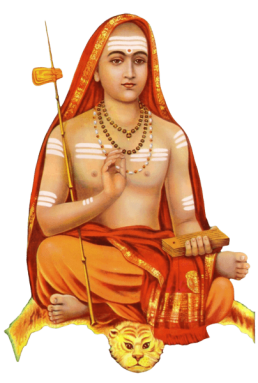सम्यक्पृष्टं त्वया विद्वन्सावधानेन तच्छृणु ।
प्रामाणिकी न भवति भ्रान्त्या मोहितकल्पना ॥ १९४ ॥
samyakpṛṣṭaṃ tvayā vidvansāvadhānena tacchṛṇu |
prāmāṇikī na bhavati bhrāntyā mohitakalpanā || 194 ||
न घटेतार्थसंबन्धो नभसो नीलतादिवत् ॥ १९५ ॥
na ghaṭetārthasaṃbandho nabhaso nīlatādivat || 195 ||
प्रत्यग्बोधानन्दरूपस्य बुद्धेः ।
भ्रान्त्या प्राप्तो जीवभावो न सत्यो
मोहापाये नास्त्यवस्तुस्वभावात् ॥ १९६ ॥
pratyagbodhānandarūpasya buddheḥ |
bhrāntyā prāpto jīvabhāvo na satyo
mohāpāye nāstyavastusvabhāvāt || 196 ||
मिथ्याज्ञानोज्जृम्भितस्य प्रमादात् ।
रज्ज्वां सर्पो भ्रान्तिकालीन एव
भ्रान्तेर्नाशे नैव सर्पोऽपि तद्वत् ॥ १९७ ॥
mithyājñānojjṛmbhitasya pramādāt |
rajjvāṃ sarpo bhrāntikālīna eva
bhrānternāśe naiva sarpo’pi tadvat || 197 ||
उत्पन्नायां तु विद्यायामाविद्यकमनाद्यपि ॥ १९८ ॥
अनाद्यपीदं नो नित्यं प्रागभाव इव स्फुटम् ॥ १९९ ॥
Previous non-existence—Prâgabháva—a term of Hindu logic. When we say a thing comes into being at a definite point of time, we imply also that there was non-existence of that particular thing prior to the moment of its birth. And this ‘nonexistence’ is obviously beginningless. But it ceases as soon as the thing comes into being. Similarly, Avidya which means absence of Vidya or knowledge, even though beginningless, disappears when realisation comes.
यद्बुद्ध्युपाधिसंबन्धात्परिकल्पितमात्मनि ॥ २00 ॥
संबन्धस्त्वात्मनो बुद्ध्या मिथ्याज्ञानपुरःसरः ॥ २0१ ॥
ब्रह्मात्मैकत्वविज्ञानं सम्यग्ज्ञानं श्रुतेर्मतम् ॥ २0२ ॥
brahmātmaikatvavijñānaṃ samyagjñānaṃ śrutermatam || 202 ||
ततो विवेकः कर्तव्यः प्रत्यगात्मसदात्मनोः ॥ २0३ ॥
tato vivekaḥ kartavyaḥ pratyagātmasadātmanoḥ || 203 ||
यथा भाति तथात्मापि दोषाभावे स्फुटप्रभः ॥ २0४ ॥
yathā bhāti tathātmāpi doṣābhāve sphuṭaprabhaḥ || 204 ||
प्रतीतिरेतस्य भवेत्प्रतीचः ।
ततो निरासः करणीय एव
सदात्मनः साध्वहमादिवस्तुनः ॥ २0५ ॥
pratītiretasya bhavetpratīcaḥ |
tato nirāsaḥ karaṇīya eva
sadātmanaḥ sādhvahamādivastunaḥ || 205 ||
विकारित्वाज्जडत्वाच्च परिच्छिन्नत्वहेतुतः ।
दृश्यत्वाद्व्यभिचारित्वान्नानित्यो नित्य इष्यते ॥ २0६ ॥
vikāritvājjaḍatvācca paricchinnatvahetutaḥ |
dṛśyatvādvyabhicāritvānnānityo nitya iṣyate || 206 ||
Vivekachudamani – Introduction
1: Devoted Dedication
2: Glory of Spiritual Life
3: Unique Graces in Life
4-7: Miseries of The Unspiritual Man
8-13: Means of Wisdom
14-17: The Fit Student
18-30: The Four Qualifications
31: Bhakti – Firm and Deep
32-40: Courtesy of Approach and Questioning
41-47: Loving Advice of the Guru
48-49: Questions of the Disciple
50: Intelligent Disciple – Appreciated
51-55: Glory of Self-Effort
56-61: Knowledge of the Self-Its Beauty
62-66: Direct Experience – Liberation
67-71: Discussion on Questions Raised
72-75: Gross Body
76-82: Sense Objects a Trap – Man Bound
83-86: Fascination for Body Criticised
87-91: Gross Body Condemned
92: Organs of Perception and Action
93-94: Inner Instruments
95: The Five Pranas
96-101: Subtle Body – Effects
102: Functions of Prāna
103-105: Ego Discussed
106-107: Infinite Love – the Self
108-110: Māyā – Pointed Out
111-112: Rajoguņa – Nature and Effects
113-116: Tamoguņa – Nature and Effects
117-119: Sattvaguņa – Nature and Effects
120-121: The Causal Body – Its Nature
122-123: Not-Self – Description
124-135: The Self – Its Nature
136: Advice for Self-control
137-142: What is Bondage – The Reply
143-144: The Powers – Agitation and Veiling
145-146: Bondage in Action
147-153: Ātman and Anātman – Discrimination
Negation of the Kośas
154-164: – Annamaya kośa (Food sheath)
165-166: – Prņamaya kośa (Vital air sheath)
167-183: – Manomaya kosa (Mental sheath)
184-188: – Vijnanamaya kośa (Intellectual sheath)
189-191: Ātman – Unattached
192-193: What is Liberation? – Disciple
194-206: Self-Knowledge gives Liberation
207-210: Anandamaya kośa (Bliss sheath)
211: Ātman – Other than the Five Kośas
212: What is Ātman? – Disciple
213-225: Nature of the Self – Discussion
226-236: All Manifestation Absolute
237-240: Brahman – Its Nature
241-249: That Thou Art – Explanation
250-253: Attitude in Meditation
254-266: Aids to Meditation
267-276: Give up Vāsanās – the Method
277-292: End Superimposition – The Means
293-297: The Perceived I’ Factor – False
298-309: Condemnation of the Ego
310-319: Actions, Thoughts and Vāsanās – Renounce
320-329: Total Vigilance – Its Price
330-338: In the One, No Plurality
339-348: Spiritual Growth – the Secret
349-353: Cause-Effect – False
354-372: Samadhi – Its Nature
373-378: Fully Detached – Samadhi Easy
379-383: Meditation – the Technique
384-397: Continuous Attention to Self
398-406: No Diversity in Reality
407-413: Ātma-vicāra – Contemplation
414-418: Give up Perceptions
419-425: The Science of Reality – Its Benefits
426-445: Signs of a Realised Seer
446-464: Prārabdha for a Saint
465-471: There is No Plurality
472-479: Experience of Selfhood
480-520: Practice of Knowledge – Disciple
521-575: Final Words of Advice
576-578: Blessed Disciple Liberated
579-581: The Glory of the Textbook

Vivekachudamani – Verses 194-206 – Vivekachudamani Verses 194-206 – By Adi Sankaracharya – In Sanskrit with English Meaning, Transliteration, Translation, Commenary, Lyrics, Audio – Vivekachudamani-194-206
